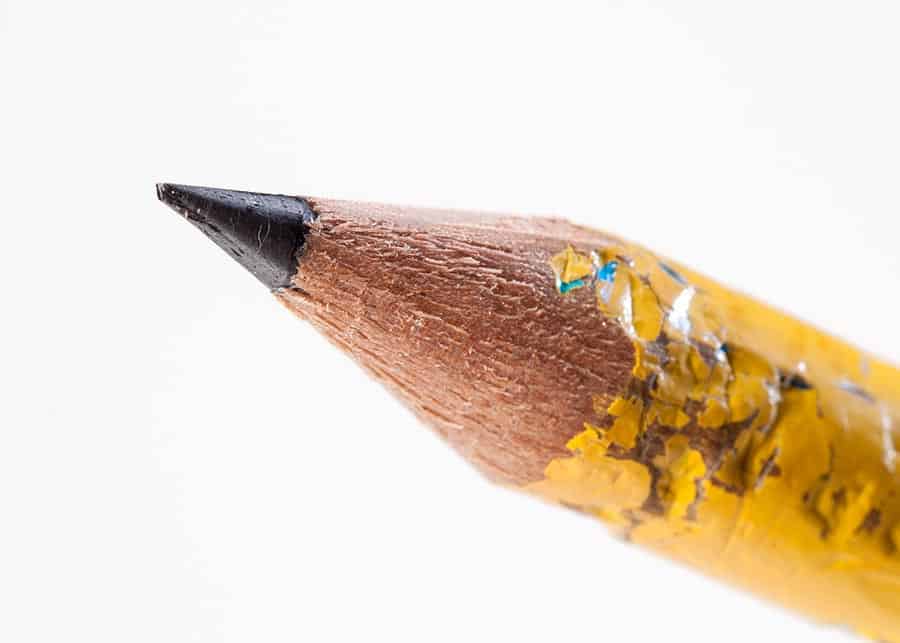
Above: Ticonderoga’s kiddie pencil shouldn’t be underestimated as a writing instrument. Photo by Mark Lyndersay.
BitDepth#1231 for January 09, 2020
Consider the pencil. It is a shaft of painted wood with a core of graphite and clay.
Many are capped with a perfectly useless eraser and the paint is almost universally bitter and flaky.
Yet what we often miss is just how sophisticated and final a piece of work it is.
They range in quality from the blindingly expensive Palomino Blackwing to cheap rubbish with fragile cores that fracture the first time they are dropped or worse are machined with off-centre cores – both of which are impossible to sharpen reliably.
The delicious mystery of the creation of the common lead pencil inspired Leonard E Read’s excellent 1958 essay explaining the invisible hand of the free market, I, Pencil.
Of the apparent simplicity of the common pencil, Read wrote, “Yet, not a single person on the face of this earth knows how to make me.”
“This sounds fantastic, doesn’t it? Especially when it is realized that there are about one and one-half billion of my kind produced in the U.S.A. each year.”
“Pick me up and look me over. What do you see? Not much meets the eye—there’s some wood, lacquer, the printed labelling, graphite, lead, a bit of metal, and an eraser.“
For all the reasons offered in that 62-year-old essay, good pencils remain rare in stores even today, and truly horrible mass-market editions are the pencils most of us will end up using, forever tainting any memory we might have had of using an excellent one in our youth.
My own reintroduction was the result of personal circumstances that left me resharpening dozens of pencils and crayons and along the way, picking a few up to use.
A few years in, I no longer use pens very much anymore.
I now have a renewed respect for Staedtler’s white erasers and have transferred my preference in writing instrument from fountain pen facsimile ballpoint to Ticonderoga’s 2HB beginner’s pencils, which marry a smooth writing point with a hefty, double-sized barrel that’s addictively comfortable.
The only downside is that this pencil needs to sharpened twice as frequently and needs a special sharpener for the bigger shell.
If you have a choice, always get hexagonal barrels instead of round ones. Picking up pencils that roll off your desk never becomes exciting.
In day to day use, I almost never use an eraser, preferring instead to slide the broad edge of the exposed tip across the offending characters, sometimes shading them into a bold smear of graphite.
The effect is oddly pleasing, like drawing a gray curtain over an error and is quite unlike doing the same thing with a pen, which has a sharper tip that catches the fibers of the paper, creating an unpleasant wrangling of intent between instrument, substrate and fluid that always results in an unsightly mess.
You will always find the best pencils in an art shop, but it’s worth it to find the upscale brands manufactured for general use.
I’m fond of Ticonderoga’s general use pencils, but Staedtler, Palomino and Faber-Castell all have general market editions of their best products.
You might think that since we celebrate technology in this space that there might be some love for mechanical pencils, but you would be terribly mistaken.
I’ve never used a mechanical pencil that didn’t feel wrong, the way that cheap leatherette does when you pinch it between your fingers.
The lead tips of mechanical pens never glide over paper properly, they always feel top-heavy and the ones that are professionally balanced manage to feel both over engineered and excessive.
The properly made pencil is overdue for a resurrection. There’s more than enough being committed to paper today that would benefit from the reconsideration an eraser enables.
Choosing your point
The grading of pencils seems arcane, but turns out to be pretty straightforward if you have the patience to figure it out.
The number is an indicator of how hard the core is. Normal pencils are designated 2, but higher numbers leave a lighter mark on paper. Lower numbers use less clay and more graphite and scribe darker.
The H and HB scale runs in parallel, indicating that the pencil writes hard (more clay) and leaves a dark mark.
The designation 2HB is considered the midpoint of all possible pencil gradings, so an HH lead writes very hard and a BBB lead leaves a very black mark. An F grade notes that the pencil can be sharpened to a very fine point, useful for artists seeking a delicate line.
Unfortunately, these gradings aren’t part of an international standard and are subject to manufacturer and regional gradings.
Some manufacturers use a combination of numbers and letters to describe what to expect from the pencil’s lead.
Pencils.com, an excellent source of information about, well, pencils, has a sample pack for anyone interested in comparing some premium pencil brands.


